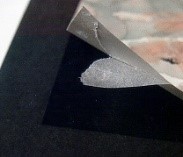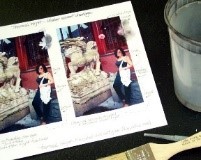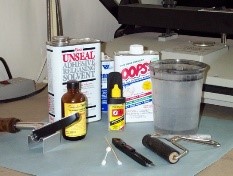 Photo 1
Photo 1
Leaving a paper image in a press too hot, too long will permanently fuse it to the back of the image making near impossible to remove.
The terms conservation, preservation, archival and museum are often used interchangeably, though there are subtle differences between them. Conservation is the act of restoring something to its original state, whereas preservation is the act of maintaining something in its current state and protecting it from additional changes. Preservation attempts to house art in its current condition by offering the most stable environment possible, and avoiding any procedure or material used that is not reversible. Removable does not mean reversible. Archival (museum) treatment usually refers to the relative permanence of the materials used, their ability to remain stable over time, and also not altering the art's original state in any way.
Within the realm of conservation mounting—wet, spray, pressure activated and dry mounting don't actually deserve much discussion. The fact is, that anytime an item is aggressively glued down the conservation concept of a museum presentation is lost, as you may never truly bring that item back to its original un-bonded state. The procedure of removing an item once mounted to a substrate almost always leaves traces of adhesive residue behind. Even a miniscule amount of adhesive that has soaked into the paper or fabric has altered that artwork from its original state, deeming it not reversible. Reviewing adhesive removal techniques and solvents may better explain this.
Tissue Use vs. HA Boards
Preservation treatment favors starch hinging for limited editions, parchment, vellum, papyrus, bark paintings, fiber-based photographs, and original art; and lacing for needle-art, stitchery, textiles and silks over adhesive mounting of any kind. But that leaves a lot of digital, paper based, and non-valuable imagery that does well when mounted. Framing adhesives come as tissues and heat-activated (HA) pre-coated boards. When to use a tissue over an HA board will depend upon each individual situation.
When dry mounting, the smartest tissue adhesive selection would be one that mounts quickly, at the lowest possible temperature, has a buffered neutral pH core, and is at least removable. Permanent adhesives and HA boards bond in the press as they reach bonding temperature. Removable adhesives bond outside the press as they cool down under a weight. And reversible adhesives and HA boards have their own set of proper mounting techniques. Check with specific manufacturers for additional information. And yes, there are two HA boards specifically designed to be considered reversible.
Bond and Removal
Bond failure occurs with improper use of the time, temperature, pressure, moisture (TTPM) guidelines, when the anticipated bond fails expectations. Intentionally breaking a bond is when a correctly fused item needs to be removed from that bond. Photos—both analog and digital—and paper may be removed by a number of different methods depending on the adhesive and sensitivities. The physical difference in the paper they are printed on will also react in different ways. Slick paper stock and analog RC photos resist adhesive absorption so removal is much easier, but textured, rag paper stocks, and some digital photo papers may cling aggressively to removable tissue.
When a thermoplastic (heat activated) adhesive is rewarmed in a press it allows for removal. This is the action of using heat as a solvent. The reapplication of heat may also break the bond of dried out, long time fused pressure-sensitive tapes and spray adhesives. The heat softens the adhesive allowing for easier separation, though adhesive residue remains soaked into both surfaces. Removable tissues and films are reactivated by putting them back into the heat of the press. When adequate time (longer than initial bond) and temperature (10°F hotter) have been met, the adhesive softens enough to be separated from the substrate. After removal, there will be adhesive residue remaining on the back of the artwork. To remove the maximum amount of adhesive without the use of solvents, continue to remount and remove the art until it will no longer hold to a new clean substrate.
Though removable tissue adhesives are designed to reactivate for ease of removal, thermal damage may occur when placing a removable tissue into a press that is too hot for too long. The adhesive then excessively absorbs into both the substrate and artwork making it extremely difficult to separate the remaining tissue from the back of the art, essentially the art and mountboard become one. (photo 1)
 Photo 1
Photo 1
Leaving a paper image in a press too hot, too long will permanently fuse it to the back of the image making near impossible to remove.
Since dry mount adhesives travel toward the heat source as they bond a possible precaution during removal might be to reheat the project face down. The adhesive will then be more likely to pull into the disposable substrate than the print attempting to be salvaged. Always remove the image from the tissue/substrate unit rather than the image and adhesive together. Trying to separate the tissue adhesive from the image once removed from a rigid substrate is more difficult because of the quickness of the cooling. A mat or mountboard substrate holds the heat longer while pulling the removable layers apart.
Types of Solvents
The idea behind removal is breaking the adhesive bond between a mountboard and what is mounted. Liquids that breakdown or dissolve other substances are known as solvents. Adhesive removal techniques include water, evaporative, chemical, and thermal solvents. The most common solvent is water, though chemical solvents are generally the ones thought of first when the term solvent is used. In the case of thermal, the very heat that was applied to create the bond is used to break that bond by softening the adhesive, so heat is the solvent.
When water is used to remove an item, it often involves starch pastes. Since water seems noninvasive, water solvents may give a feeling of safety and security when mounting. There are wet glues and sprays that are water soluble though may not be totally reversible, and sometimes water can damage the art, as with some waterbase digital inkjet. (photo 2) Chemical solvents will not damage water based inks, and water will not harm chemical based inks.
 Photo 2
Photo 2
Notice the damage difference between the digital photos of Kodak Paper left and HP Photo Paper right. Both damaged, but very differently.
Evaporative and chemical solvents are those used in paints, varnishes, and plastic coatings to keep them liquid. Once those solvents evaporate or dissipate, the liquid solution becomes a tough solid. These are the type used that allow a spray adhesive to be shot from the nozzle of a can in the first place, and many of these are indeed chemical in nature. Check manufacturer guidelines for additional information.
Solvents for Wet Glues and Sprays
As sprays age, the bonding agents holding them to the substrate dry out and may begin to lift from the substrate. If a partially peeled or bubbled poster has been returned for remounting the bond may be weakened by placing the partially mounted image into a 180°F press for a few minutes. That will often slightly activate the old spray adhesive enough to allow it to be peeled from the backing board.
As with dry mount tissues and some tapes and adhesives used for manual mounting and cold vacuum frames fall into similar removable and acid-free categories. Some EVAs (ethyl vinyl acetate) remain water activated once dry and may be softened for removal, while other PVAs (poly vinyl acetate) are water soluble when wet glues but do not reactivate with water once dry. And some may be removable heat activated adhesives by heating with a hair dryer or shrink-wrap gun to reactivate its thermoplastic adhesive. Read your MSDS sheets for adhesive details.
Chemical Solvents
Permanent dry mount tissues bond under heat as they reach bonding temperature and are not heat removable after bonding. They may be removed by using specially formulated strong, hazardous, chemical solvents that evaporate quickly when exposed to open air. These chemicals dissolve most dry mount, spray, and pressure-sensitive adhesives allowing for removal and possible remounting. There are commercial adhesive release formulations including Unseal, Undo, and Bestine Thinner as well as mineral spirits, toluene, and acetone. (photo 3)
 Photo 3
Photo 3
Common chemical solvents are flanked by water solvent and eyedropper (right), heat solvent tacking iron and 210 press in back. Test all images for solvent sensitivity before using.
Fumes are present when using these solvents, so they should only be used in well-ventilated areas. Some chemical solvents may also be used as surface cleaner for traditional analog photographs to remove fingerprint oils and to clean press platens of alien adhesives.
Solvents for Tape
Some tapes are water soluble (as with water activated preservation linen), some require chemical solvents for removal, and some dry up and fall off in time. Two additional methods for tape removal include applying heat as a thermal solvent using a tacking iron to reactivate the adhesive, or lighter fluid (as a chemical solvent) brushed on in a small amount to dissolve adhesives.
ATG tape is available with acrylic adhesive and rubber adhesive. Acrylic (based) adhesive has a high level of clarity and never turns yellow when exposed to natural light. Rubber (based) adhesive offers a quick, secure bond on a multitude of surfaces, are considered neutral, yet are prone to yellowing. The question then is whether neutral pH products will remain non-staining and non-damaging over the test of time. Staying clear of rubber based adhesives touching art is advised.
Final Mount
Since removable dry mount tissues bond under a weight as they cool, it stands to reason their removability will be achieved by reheating them. Permanent tissues bond in the press as all layers reach full bonding temperature so they are only removable through the use of chemical solvents. Many wet and spray glues are water soluble making them removable, non-staining and won't dry out, though may not be neutral pH.
Reversible adhesives leave no adhesive residue behind, while the others have altered the original art. If preservation methods of mounting are in order, pull out your Japanese hinges, edge strips, or Mylar corners and think reversible. If alternative methods of mounting are being considered, removable may be in order...otherwise there's nothing wrong with those good old permanent adhesives. It depends on the project.
END
Copyright © 2022 Chris A Paschke
For more articles on mounting basics look under the mounting section in Articles by Subject.
Additional information on all types of mounting is found in:
The Mounting and Laminating Handbook, Second Edition, 2002,
The Mounting And Laminating Handbook, Third Edition, 2008 and
Creative Mounting, Wrapping, And Laminating, 2000 will teach you everything you need to know about getting the most from your dry mount equipment and materials as an innovative frame designer.
All books are available from Designs Ink Publishing through this website.
Chris A Paschke, CPF GCF
Designs Ink
Designs Ink Publishing
785 Tucker Road, Suite G-183
Tehachapi, CA 93561
P 661-821-2188
chris@designsinkart.com